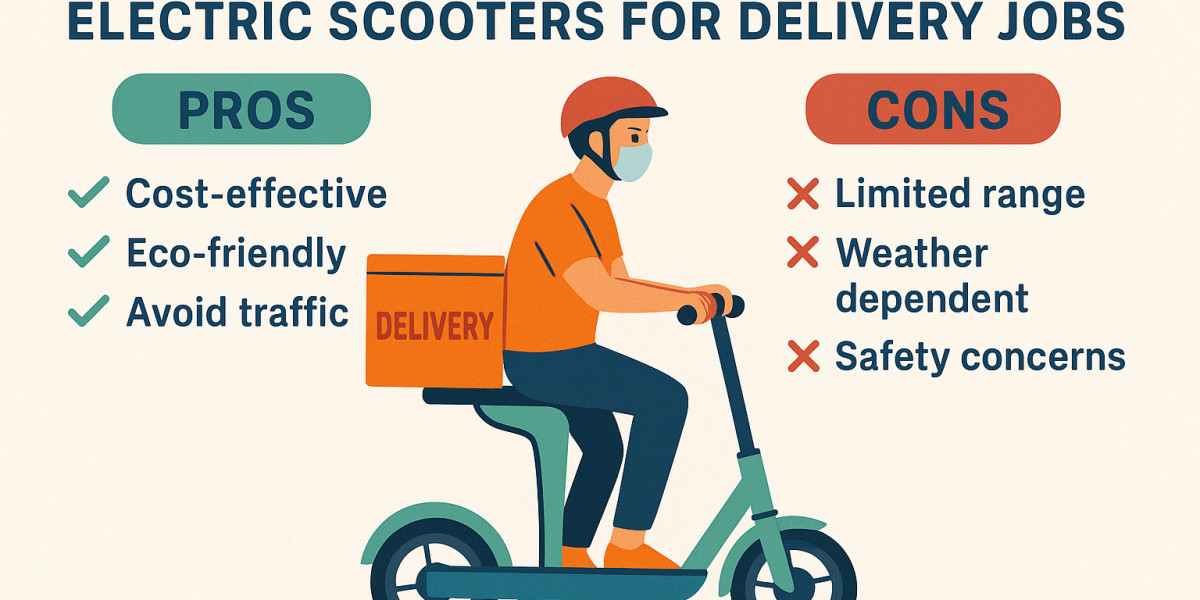The rise of the gig economy has changed the way many view work, particularly delivery services. From food delivery platforms such as Uber Eats, DoorDash and Deliveroo to parcel delivery startups and local courier businesses; fast and efficient transportation has never been so in demand - creating new opportunities for alternative vehicles like electric scooters to make deliveries.
Electric scooters may seem ideal for delivery drivers; but are they really practical in terms of efficiency, cost efficiency and convenience? In this post we explore both sides of using an e-scooter as part of your delivery job based on real world research insights.
Why Are Electric Scooters Entering the Delivery Market?
Over the past decade, cities worldwide have increasingly turned towards sustainable transportation options to combat carbon emissions, traffic congestion, and rising fuel costs. Delivery companies as well as individual riders alike are turning towards electric vehicles for delivery services or individual use.
Electric scooters were once seen solely as leisure vehicles; now, however, they're increasingly being adopted as last mile delivery solutions. Their lightweight construction, low operating costs and eco-friendly advantages make them suitable for urban delivery services in Europe and Asia.
Pros of Using Electric Scooters for Delivery Jobs
Cost-Effective Transportation
Fuel costs can be one of the greatest expenses for delivery riders. Electric scooters run on rechargeable batteries instead of gas engines and significantly cut costs as charging often costs under $1 per full charge; many models can travel between 25-60 miles depending on battery capacity.
Over time, this adds up to significant savings; making scooters one of the most cost-efficient delivery vehicles on offer.
Eco-Friendly Delivery Solution
Sustainability has long been considered essential by both governments and customers, including electric scooter users. Zero direct emissions made possible through electric scooters help lower air pollution in congested cities while many consumers now favor eco-friendly businesses; companies implementing green delivery solutions gain a competitive advantage over rivals by adopting sustainable practices.
Promoting electric scooter usage within businesses also builds brand reputation as socially and ecologically aware.
Improved Navigability in Urban Areas
One of the key challenges of delivery riders is navigating heavy traffic. Electric scooters provide delivery riders with an effective solution, as their compact design enables them to easily pass through congested streets and reach customers faster while needing less parking space - ideal when making multiple deliveries across busy neighborhoods.
Scooters typically outclass cars and vans when it comes to delivery times in cities with dense populations, making them perfect for last-mile delivery jobs.
Low Maintenance Costs
Electric scooters require far fewer moving parts and repairs compared to motorcycles or cars, meaning maintenance costs tend to be considerably less expensive. Regular checks typically focus on brakes, tires and battery health instead.
Electric scooters make ideal delivery vehicles because their low maintenance requirements allow riders to maximize earnings without incurring costly repair expenses.
Affordable Purchase Price
Although more luxurious models can be more costly, most delivery-ready foldable electric scooters are often much less costly to own compared to motorcycles or cars. Furthermore, some companies provide financing or rental options specifically for delivery riders - providing new couriers a budget-friendly entry into this sector of transport.
Growing Infrastructure Support
As governments encourage renewable energy use, charging infrastructure has rapidly increased across cities worldwide. Public charging stations now exist throughout many major metropolises while portable chargers make topping up batteries easier between shifts - all helping make scooters suitable for professional delivery work.
Cons of Using Electric Scooters for Delivery Jobs
Limited Range and Battery Life
Electric scooters' main limitation lies in their short mileage per charge of 25-60 miles; though this might suffice for urban deliveries, long delivery shifts or rural routes might necessitate multiple charges and create downtime during which riders wait to recharge which reduces earnings and causes downtime during shifts.
Charging Time
Compared with fueling up a motorcycle, which typically only requires minutes, charging an e-scooter may take hours depending on its model and even with fast-charging options riders must plan shifts around battery life - something not always ideal during high demand delivery periods.
Weather Limitations
Scooters are highly exposed vehicles. While motorcycles also face weather challenges, electric scooters may be especially susceptible. Heavy rain, snowfall or extreme temperatures could impact performance and safety in some regions, possibly restricting year-round usability in certain cases.
Load Capacity
Deliverers typically need to transport multiple packages, groceries or large food orders simultaneously. Electric scooters typically feature smaller storage compartments than motorcycles or cars and often don't offer enough carrying space despite accessories like delivery boxes or backpacks being added; making bulk delivery impossible on an electric scooter.
Regulatory Restrictions
Not all cities treat electric scooters similarly. Some cities restrict them on main roads or highways, restricting where delivery riders can travel. Licensing requirements, speed restrictions, and safety regulations all vary by jurisdiction - creating complications for riders as well as businesses alike.
Durability Issues
While electric scooters continue to improve in quality, their build may still not match up against motorcycles for heavy daily use. Exposed to potholes, rough roads and long working hours may reduce lifespan compared to more robust delivery vehicles.
Tips for Delivery Riders Utilizing Electric Scooters
If you are thinking about using an electric scooter as part of a delivery job, here are a few strategies for optimizing efficiency:
Choose an Appropriate Scooter: Look for models with at least 30-40 miles of range, durable tires and strong suspension.
Invest in Portable Chargers: This way you can recharge during breaks without losing precious delivery time.
Use insulated Delivery Bags: As scooters offer limited storage capacity, high-quality backpacks help preserve food quality while expanding carrying capacity.
Plan Delivery Routes: Plan delivery routes taking into account battery life and charging stations for optimal delivery routes.
Maintain Regularly: Regular maintenance checks on brakes, tires and batteries can prevent interruption during peak hours and result in downtime for your business.
Final Thoughts
Electric scooters may be suitable options for delivery work; with certain conditions. Electric scooters provide an economical, eco-friendly, and efficient means of urban food and courier delivery services in short distance areas; however there may be limitations due to range, charging time or weather considerations which must be addressed first.
Electric scooters may offer delivery riders and businesses operating within urban environments several advantages over motorcycles or cars/vans; however, for long distance or bulk deliveries traditional motorcycling, cars, or vans may still be more suitable options.
As technology improves, electric scooters may gain further ground. At present though, they remain an economical and scalable delivery method provided riders choose an appropriate scooter and adjust their workflow to account for its constraints.








